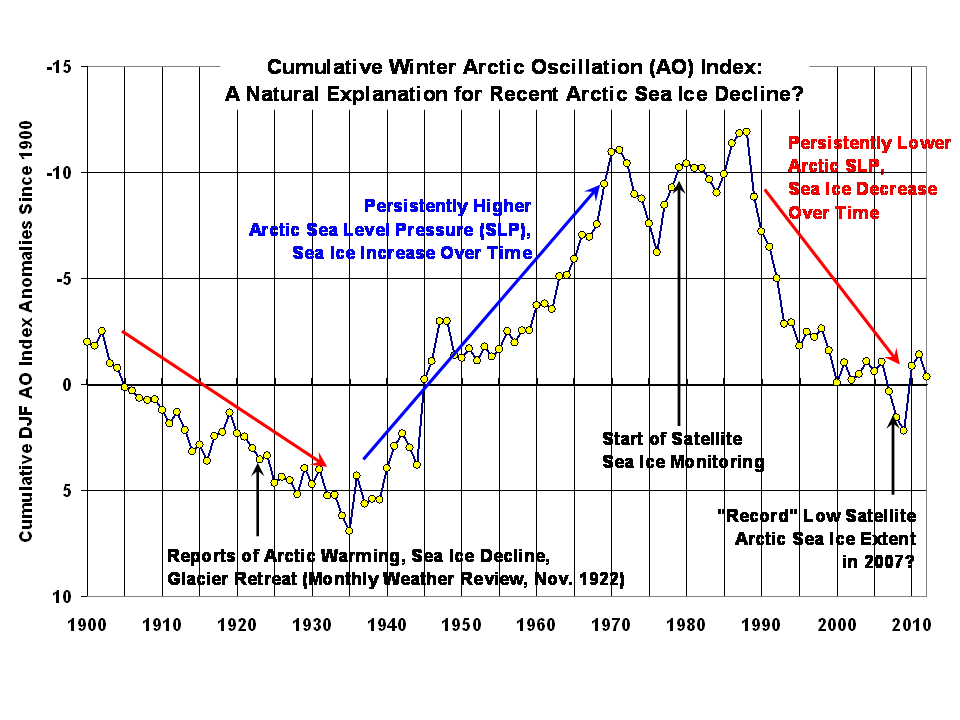While the IPCC claims that recent Arctic sea ice declines are the result of human-caused warming, there is also convincing observational evidence that natural cycles in atmospheric circulation patterns might also be involved.
And unless we know how much of the decline is natural, I maintain we cannot know how much is human-caused.
In 2002, a paper was published in the Journal of Climate entitled Response of Sea Ice to the Arctic Oscillation, where the authors (one of whom, Mike Wallace, was a co-discoverer of the AO) shows that changing wind patterns associated with the AO contributed to Arctic sea ice declines from one decade to the next: from 1979-1988 to 1989-1998.
The Arctic Oscillation involves sea level pressure patterns over the Arctic Ocean, North Atlantic, and North Pacific. Since sea ice moves around with the wind (see this movie example), sea level pressure patterns can either expose or cover various sections of the Arctic Ocean.
When there are many winters in a row with high (or low) pressure, it can affect sea ice cover on decadal time scales. Over time, ice can become more extensive and thicker, or less extensive and thinner.
There is a time lag involved in all of this, as discussed in the above paper. So, to examine the potential cumulative effect of the AO, I made the following plot of cumulative values of the winter (December-January-February) AO (actually, their departures from the long-term average) since 1900. Iíve attached a spreadsheet with the data for those interested, updated through this past winter.

Consistent with the analysis in the above-cited paper, the sea ice decline since satellite monitoring began in 1979 was during a period of persistent positive values of the AO index (note the reversed vertical scale). Since the satellite period started toward the end of a prolonged period of negative AO values, this raises the question of whether we just happened to start monitoring Arctic sea ice when it was near peak coverage.
Note that back in the 1920ís, when there were reports of declining sea ice, record warmth, and disappearing glaciers, there was similar AO behavior to the last couple of decades. Obviously, that was before humans could have influenced the climate system in any substantial way.
I wonít go into what might be causing the cyclic pattern in the AO over several decades. My only point is that there is published evidence to support the view that some (or even most?) of the ~20 year sea ice decline up until the 2007 minimum was part of a natural cycle, related to multi-decadal changes in average wind patterns.

 Home/Blog
Home/Blog




Current Arctic temperatures near the surface.
https://i.ibb.co/82zGvWg/ventusky-temperature-5cm-20240401t1400.jpg
https://i.ibb.co/WsPdSRx/ventusky-temperature-5cm-20240401t1400-1.jpg
Since the beginning of March, the extent of ice in the Barents Sea has increased by 300,000 square kilometers.
https://i.ibb.co/PM7YVbr/r06-Barents-Sea-ts-4km.png
https://i.ibb.co/TBhY84L/r00-Northern-Hemisphere-ts-4km.png
The angle of inclination of the Earth’s axis to the perpendicular to the ecliptic is at mid-decline. It will take several thousand years for the next glaciation to occur, but snowfall is increasing and will continue to increase over the next hundreds of years.
https://ccin.ca/home/sites/default/files/snow/snow_tracker/nh_swe.png